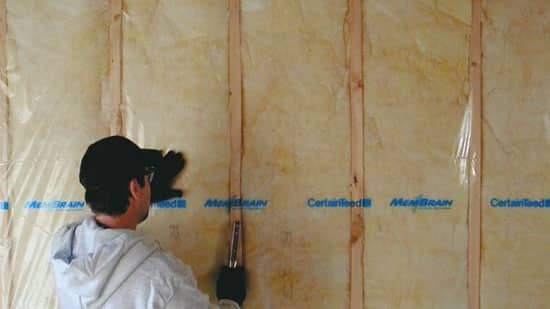In the 2021 Energy Code a new exterior wall system was introduced, the 0+20 CI (continuous insulation) wall. The new 0+20 CI wall is 2×4 framing with no insulation needed between the studs and an R-20 of CI insulation over the exterior wall which translates to 4” of depth of ridge foam boards in most cases which is an R-20.
The point of this new wall assembly is to remove the vapor barrier from the inside of the wall assembly which is a known potential problem since it was introduced back in the 1980’s. The problem is that products such as plywood, OSB, and other composite sheathings that can trap moisture in the insulation between the plastic vapor barrier on the inside of the wall and the sheathing on the outside of the wall in colder climates.
With the 13+10 CI and 20+5 CI wall systems you have a possibility to trap water between 3 vapor barriers. The plastic sheathing on the inside of the wall, the wall sheathing and now the ridged foam on the outside of the wall sheathing. There are too many ways to trap water or moisture in these new hybrid CI wall assemblies and that is one reason why builders do not like these new CI walls.
The 2×6 and 2×8 EcoSmart Stud (ESS for short) wall system also removes the need for a vapor barrier. Lets look at the 2×8 ESS wall system compared to the 0+20CI wall system.
The 2×8 EcoSmart Stud wall is 7.25” thick with framing and insulation. The 0+20 CI wall is at a minimum 7.5”. No interior vapor barrier needed in either wall assembly. Both wall assemblies can dry to the inside and the outside. Both save energy and CO2 emissions. Both save embodied carbon in the exterior wall assembly. The 0+20 CI by using 2×4 framing the 2×8 ESS by its lighter weight 2×8 and the use of blown in natural fiber insulation as the back fill insulation.
This where similarities end.
The base effective R-value of the 0+20 CI wall is R-20.5. The base effective of the 2×8 ESS wall is R-28. The ridged foam insulation in the 0+20 CI wall serves as insulation and the vapor barrier. The closed cell spray foam insulation n the 2×8 ESS wall serves as insulation, vapor barrier, air infiltration barrier, and structural reinforcement. The 2×8 ESS wall is a stronger more resilient wall system because it is nailed and glued together while the 0+20 CI system is just nailed together. Any wood worker knows you nail and glue your work together for long lasting durability. Also, in wildfire area it’s a bad idea to have 4” of flammable ridged foam outside the wall assembly only protected by the siding. Closed cell spray foam and cellulose insulation is class 1 fire rated and protected by the siding, air gap, then sheathing.
Cost. The 2×8 ESS wall system is far less expensive and simpler to build then the 0+20 CI wall system.
The 2×6 or 2×8 ESS wall system doesn’t have all the extra steps in labor and materials required to use exterior foam. With ESS your just swapping studs. Using ESS speeds up the construction process with its predrilled slots for electricians. 0+20 CI your still drilling holes in 2×4’s to run wires.
Take a look at this sheet we did a while back before the introduction of the 0+20 CI wall was introduced. While the 0+20 CI wall checks a couple more boxes it’s still not a fair match up to the ESS wall system.
